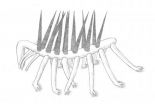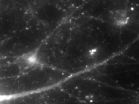(Press-News.org) Local surface uplift can block rivers, particularly in mountainous regions. The impounded water, however, always finds its way downstream, often cutting a narrow gorge into the rocks. Subsequent erosion of the rocks can lead to a complete eradication of this initial incision, until not a trace is left of the original breakthrough. In extreme cases the whole gorge disappears, leaving behind a broad valley with a flat floodplain. Previously, the assumption was that this transition from a narrow gorge to a wide valley was driven by gorge widening and the erosion of the walls of the gorges.
A team of scientists from the GFZ German Research Centre for Geosciences in Potsdam has now revealed a new mechanism that drives this process of fluvial erosion (Nature Geoscience, 17.08.2014). The geoscientists analyzed the development of a gorge on the Da'an Chi river in Taiwan over a period of almost ten years. There, uplift that was caused by the Jiji earthquake of 1999 (magnitude 7.6), and that runs transverse to the river, had formed a blockage. Earthquakes of that size occur there every 300 to 500 years. "Before the quake there was no sign of a gorge at all in this riverbed, which is one and a half kilometers wide", explains Kristen Cook of the GFZ. "We have here the world's first real-time observation of the evolution of gorge width by fluvial erosion over the course of several years." Currently the gorge is roughly a kilometer long, 25 meters wide and up to 17 meters deep. Initially, the gorge walls were eroded at a rate of five meters per year, and today are still retreating one and a half meters per year.
The scientists identified a hitherto unknown mechanism by which the gorge is destroyed. "Downstream sweep erosion" they termed this process. "A wide braided channel upstream of the gorge is necessary," explains co-author Jens Turowski (GFZ). "The course of this channel changes regularly and it has to flow in sharp bends to run into the gorge. In these bends, the bed-load material that is transported by the river hits the upper edge of the gorge causing rapid erosion." This mechanism gradually washes away all of the bedrock surrounding the gorge and, therefore, is the cause for the planation of the riverbed over the complete width of the valley. Assuming the current erosion rate of 17 meters per year, it will take here at the Da'an Chi River only 50 to 100 years until again a flat beveled channel again fills the valley. In contrast, lateral erosion in the gorge would be too slow to eradicate the gorge in the time of one earthquake cycle. The newly discovered downstream sweep erosion is far more effective.
INFORMATION:
Kristen L. Cook, Jens M. Turowski and Niels Hovius: "River gorge eradication by downstream sweep erosion", Nature Geoscience, Advance Online Publication, 17.08.2014, DOI: 10.1038/ngeo2224
A photo in printable resolution may be found here:
https://media.gfz-potsdam.de/gfz/wv/05_Medien_Kommunikation/Bildarchiv/Einzelbilder_Neuestes/Daan_River_incision_Cook_7097.jpg
Gorges are eradicated by downstream sweep erosion
New mechanism of erosion revealed
2014-08-17
ELSE PRESS RELEASES FROM THIS DATE:
Epigenetic breakthrough bolsters understanding of Alzheimer's disease
2014-08-17
A team led by researchers at the University of Exeter Medical School and King's College London has uncovered some of the strongest evidence yet that epigenetic changes in the brain play a role in Alzheimer's disease.
Epigenetic changes affect the expression or activity of genes without changing the underlying DNA sequence and are believed to be one mechanism by which the environment can interact with the genome. Importantly, epigenetic changes are potentially reversible and may therefore provide targets for the development of new therapies.
Globally, more than 26 million ...
8,000-year-old mutation key to human life at high altitudes
2014-08-17
(SALT LAKE CITY) – In an environment where others struggle to survive, Tibetans thrive in the thin air on the Tibetan Plateau, with an average elevation of 14,800 feet. A study led by University of Utah scientists is the first to find a genetic cause for the adaptation – a single DNA base pair change that dates back 8,000 years – and demonstrate how it contributes to the Tibetans' ability to live in low oxygen conditions. The study appears online in the journal Nature Genetics on Aug. 17, 2014.
"These findings help us understand the unique aspects of Tibetan adaptation ...
Microchip reveals how tumor cells transition to invasion
2014-08-17
VIDEO:
Cancer cells advance across a microchip designed to be an obstacle course for cells. The device sheds new light on how cancer cells invade and could be used to test...
Click here for more information.
PROVIDENCE, R.I. [Brown University] — Using a microengineered device that acts as an obstacle course for cells, researchers have shed new light on a cellular metamorphosis thought to play a role in tumor cell invasion throughout the body.
The epithelial-mesenchymal transition ...
'Cavity protection effect' helps to conserve quantum information
2014-08-17
The electronics we use for our computers only knows two different states: zero or one. Quantum systems on the other hand can be in different states at once, they can store a superposition of "zero" and "one". This phenomenon could be used to build ultrafast quantum computers, but there are several technological obstacles that have to be overcome first. The biggest problem is that quantum states are quickly destroyed due to interactions with the environment. At TU Wien (Vienna), scientists have now succeeded in using a protection effect to enhance the stability of a particularly ...
FDA-approved drug restores hair in patients with Alopecia Areata
2014-08-17
NEW YORK, NY (August 17, 2014) —Researchers at Columbia University Medical Center (CUMC) have identified the immune cells responsible for destroying hair follicles in people with alopecia areata, a common autoimmune disease that causes hair loss, and have tested an FDA-approved drug that eliminated these immune cells and restored hair growth in a small number of patients.
The results appear in today's online issue of Nature Medicine.
In the paper, the researchers report initial results from an ongoing clinical trial of the drug, which has produced complete hair regrowth ...
Fascinating rhythm: Light pulses illuminate a rare black hole
2014-08-17
The universe has so many black holes that it's impossible to count them all. There may be 100 million of these intriguing astral objects in our galaxy alone. Nearly all black holes fall into one of two classes: big, and colossal. Astronomers know that black holes ranging from about 10 times to 100 times the mass of our sun are the remnants of dying stars, and that supermassive black holes, more than a million times the mass of the sun, inhabit the centers of most galaxies.
But scattered across the universe like oases in a desert are a few apparent black holes of a more ...
A shift in the code: New method reveals hidden genetic landscape
2014-08-17
Cold Spring Harbor, NY – With three billion letters in the human genome, it seems hard to believe that adding a DNA base here or removing a DNA base there could have much of an effect on our health. In fact, such insertions and deletions can dramatically alter biological function, leading to diseases from autism to cancer. Still, it is has been difficult to detect these mutations. Now, a team of scientists at Cold Spring Harbor Laboratory (CSHL) has devised a new way to analyze genome sequences that pinpoints so-called insertion and deletion mutations (known as "indels") ...
New home for an 'evolutionary misfit'
2014-08-17
One of the most bizarre-looking fossils ever found - a worm-like creature with legs, spikes and a head difficult to distinguish from its tail – has found its place in the evolutionary Tree of Life, definitively linking it with a group of modern animals for the first time.
The animal, known as Hallucigenia due to its otherworldly appearance, had been considered an 'evolutionary misfit' as it was not clear how it related to modern animal groups. Researchers from the University of Cambridge have discovered an important link with modern velvet worms, also known as onychophorans, ...
Stem cells reveal how illness-linked genetic variation affects neurons
2014-08-17
VIDEO:
Human neurons firing
Click here for more information.
A genetic variation linked to schizophrenia, bipolar disorder and severe depression wreaks havoc on connections among neurons in the developing brain, a team of researchers reports. The study, led by Guo-li Ming, M.D., Ph.D., and Hongjun Song, Ph.D., of the Johns Hopkins University School of Medicine and described online Aug. 17 in the journal Nature, used stem cells generated from people with and without mental illness ...
New Stanford research sheds light on how children's brains memorize facts
2014-08-17
As children learn basic arithmetic, they gradually switch from solving problems by counting on their fingers to pulling facts from memory. The shift comes more easily for some kids than for others, but no one knows why.
Now, new brain-imaging research gives the first evidence drawn from a longitudinal study to explain how the brain reorganizes itself as children learn math facts. A precisely orchestrated group of brain changes, many involving the memory center known as the hippocampus, are essential to the transformation, according to a study from the Stanford University ...
LAST 30 PRESS RELEASES:
Numbers in our sights affect how we perceive space
SIMJ announces global collaborative book project in commemoration of its 75th anniversary
Air pollution exposure and birth weight
Obstructive sleep apnea risk and mental health conditions among older adults
How talking slows eye movements behind the wheel
The Ceramic Society of Japan’s Oxoate Ceramics Research Association launches new international book project
Heart-brain connection: international study reveals the role of the vagus nerve in keeping the heart young
Researchers identify Rb1 as a predictive biomarker for a new therapeutic strategy in some breast cancers
Survey reveals ethical gaps slowing AI adoption in pediatric surgery
Stimulant ADHD medications work differently than thought
AI overestimates how smart people are, according to HSE economists
HSE researchers create genome-wide map of quadruplexes
Scientists boost cell "powerhouses" to burn more calories
Automatic label checking: The missing step in making reliable medical AI
Low daily alcohol intake linked to 50% heightened mouth cancer risk in India
American Meteorological Society announces Rick Spinrad as 2026 President-Elect
Biomass-based carbon capture spotlighted in newly released global climate webinar recording
Illuminating invisible nano pollutants: advanced bioimaging tracks the full journey of emerging nanoscale contaminants in living systems
How does age affect recovery from spinal cord injury?
Novel AI tool offers prognosis for patients with head and neck cancer
Fathers’ microplastic exposure tied to their children’s metabolic problems
Research validates laboratory model for studying high-grade serous ovarian cancer
SIR 2026 delivers transformative breakthroughs in minimally invasive medicine to improve patient care
Stem Cell Reports most downloaded papers of 2025 highlight the breadth and impact of stem cell research
Oxford-led study estimates NHS spends around 3% of its primary and secondary care budget on the health impacts of heat and cold in England
A researcher’s long quest leads to a smart composite breakthrough
Urban wild bees act as “microbial sensors” of city health.
New study finds where you live affects recovery after a hip fracture
Forecasting the impact of fully automated vehicle adoption on US road traffic injuries
Alcohol-related hospitalizations from 2016 to 2022
[Press-News.org] Gorges are eradicated by downstream sweep erosionNew mechanism of erosion revealed







